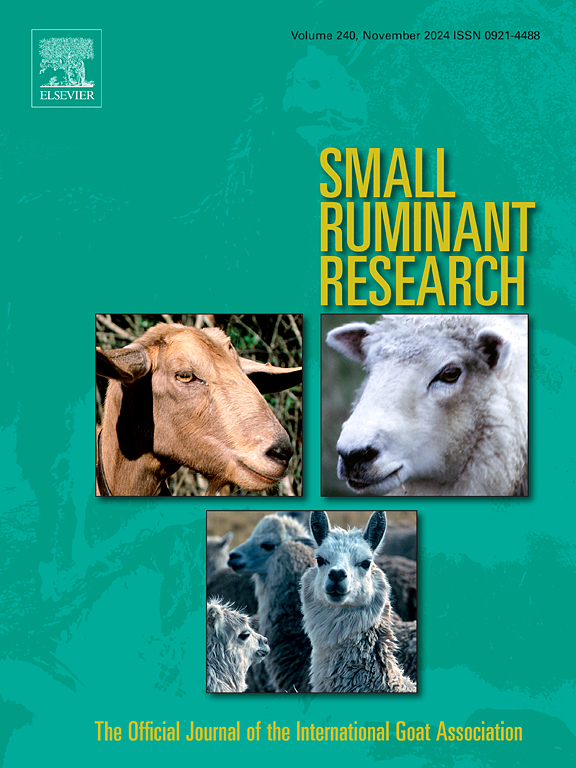Assessing anthelmintic resistance on small ruminant farms in a tropical production system
IF 1.6
3区 农林科学
Q2 AGRICULTURE, DAIRY & ANIMAL SCIENCE
引用次数: 0
Abstract
Imidazothiazoles and benzimidazole are the only classes of anthelmintic drugs that have been used over the past 40 years in Fiji. Recently, concerns have arisen that anthelminthic resistance could be widespread and affect animal health and productivity in Fiji. The present study was designed to evaluate the current anthelmintic resistance status in Fiji's small ruminant farms. The study included 11 farms from the two (Western and Northern divisions) most relevant areas of small ruminant production in Fiji. The anthelmintic treatments tested were levamisole (LEV), albendazole (ALB), levamisole + albendazole combination (LEV+ALB), ivermectin (IVM), moxidectin (MOX), closantel (CLO) and a negative control (CON). The anthelmintic’s efficacy was tested using faecal egg count reduction (FECR) tests and copro-cultures on days 14, 28, and 42 after treatment administration. The lowest mean FECR on day 14 was observed for ALB (65.2 %) followed by LEV (91.6 %), ALB + LEV (94.3 %), IVM (97.4 %) and MOX (98.8 %). The most relevant genera of GIN encountered were Haemonchus and Trichostrongylus spp., with no distinct pattern of resistance to drug groups between the two populations. None of the tested drugs (MOX and CLO) presented FECR over 95 % on days 28 and 42. Overall, the level of anthelmintic resistance observed was lower than hypothesised for this study. The combination of LEV+ALB has proven effective and presents an appealing treatment option for managing anthelmintic resistance and worm burden reduction in Fiji.
评估热带生产系统中小型反刍动物养殖场的抗虫性
咪唑噻唑和苯并咪唑是斐济过去40年来使用的唯一一类驱虫药。最近,人们对斐济的抗虫性可能普遍存在并影响动物健康和生产力感到关切。本研究旨在评估斐济小型反刍动物养殖场目前的抗虫状况。该研究包括来自斐济两个(西部和北部地区)最相关的小反刍动物生产地区的11个农场。采用左旋咪唑(LEV)、阿苯达唑(ALB)、左旋咪唑+ 阿苯达唑联合(LEV+ALB)、伊维菌素(IVM)、莫西丁素(MOX)、closantel (CLO)和阴性对照(CON)进行驱虫试验。在给药后的第14、28和42天,采用粪卵计数减少(FECR)试验和共培养来检测驱虫剂的功效。第14天平均FECR最低的是ALB(65.2 %),其次是LEV(91.6 %)、ALB + LEV(94.3 %)、IVM(97.4% %)和MOX(98.8 %)。与GIN最相关的属是Haemonchus和Trichostrongylus spp,两个种群之间没有明显的耐药模式。试验药物(MOX和CLO)在第28天和第42天的FECR均未超过95% %。总体而言,观察到的驱虫抗性水平低于本研究的假设。LEV+ALB的组合已被证明是有效的,为斐济管理驱虫病耐药性和减少蠕虫负担提供了一种有吸引力的治疗选择。
本文章由计算机程序翻译,如有差异,请以英文原文为准。
求助全文
约1分钟内获得全文
求助全文
来源期刊

Small Ruminant Research
农林科学-奶制品与动物科学
CiteScore
3.10
自引率
11.10%
发文量
210
审稿时长
12.5 weeks
期刊介绍:
Small Ruminant Research publishes original, basic and applied research articles, technical notes, and review articles on research relating to goats, sheep, deer, the New World camelids llama, alpaca, vicuna and guanaco, and the Old World camels.
Topics covered include nutrition, physiology, anatomy, genetics, microbiology, ethology, product technology, socio-economics, management, sustainability and environment, veterinary medicine and husbandry engineering.
 求助内容:
求助内容: 应助结果提醒方式:
应助结果提醒方式:


